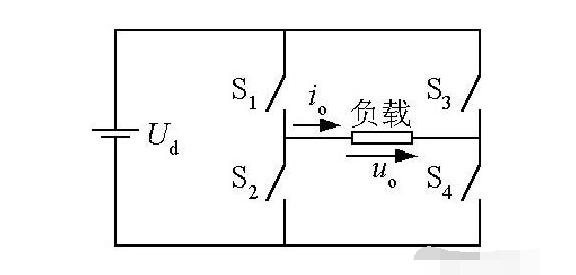
The above figure is a typical inverter equivalent diagram. There are four switches S1~S4 forming two bridge arms, switches S1 and S2 are the same bridge arm, S3 and S4 are one bridge arm. When switches S1 and S4 are closed and S2 and S3 are disconnected, Uo=Ud can be obtained on the load resistance. When switches S2 and S3 are closed and S1 and S4 are off, Uo=-Ud can be obtained on the load resistance. With the continuous operation of the switch, an AC waveform is obtained on the load, and the process of converting DC into AC is completed. The waveform is as shown below:
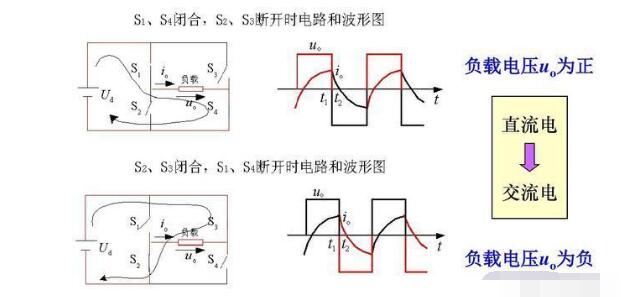
It should be noted that the switches on the same bridge arm cannot be closed at the same time so as to avoid a short circuit of the power supply. The frequency of the alternating current can be changed by changing the frequency of the switch. In fact, the four switches in the figure above are ideal models for various semiconductor switching devices. The semiconductor switching devices commonly used in inverter circuits are thyristors, field effect transistors, and insulated gate transistors (IGBTs). For example, the following figure shows a switching circuit formed by a field effect transistor.
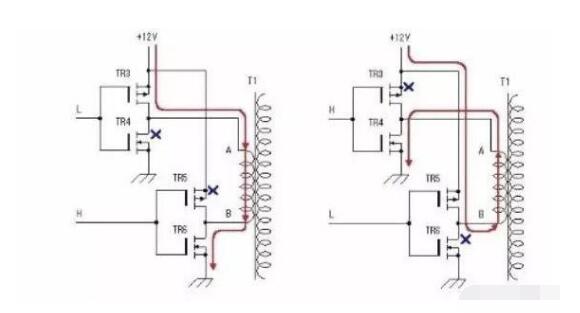
As shown in the figure, the switching device of the circuit is composed of an N-channel field-response transistor and a P-channel enhancement type field-effect transistor to form a push-pull output. When the driving signal is a low level L, the P-channel FET conduit, when the input signal is a high level H, the N-channel field tube conduit, this alternate conduction avoids simultaneous conduction of the two switches of the same bridge arm Causes a power short circuit hazard. The working process is as follows. The FETs TR3 and TR4 are the same bridge arm, and the TR5 and TR6 are the same bridge arm. The four switch tubes are controlled by the pulse signal to turn on and generate the alternating signal to be applied to the low voltage winding of the transformer. The windings will induce high-voltage alternating currents and complete the conversion from DC to AC.
What are the factors that affect the life of the inverter?The inverter is the core of the power station. Its life span affects the normal operation of the entire power station. The lifespan of the inverter has become a matter of great concern to everyone. What are the factors that affect inverter life? In the following, we analyze the factors affecting inverter life from the aspects of device life, design, and installation.
1, device life
The inverter belongs to the switching power supply from the broad sense, so its components can basically be divided into resistors, capacitors, diodes, power devices (IGBT or MOS), inductors and transformers, current sensors, ICs, optocouplers, and relays.
The service life of resistors, chip capacitors and ceramic capacitors can generally reach 20 years or more. In the design of inductors and transformers, as long as the material temperature is not exceeded, it is theoretically considered that it can work for a long time without failure; low-power diodes The triode can work for more than 100,000 hours; the mechanical life of the relay is generally more than 1 million times, and the electrical life is more than 10,000 times; the power device IGBT or MOS does not generally consider the service life as long as it satisfies the design specifications. Fans and fuses are fragile components, which will not affect the life of the inverter. They only need to be replaced in time. The life of the film capacitor is more than 100,000 hours. The life of the electrolytic capacitor is generally 2000- at 105°C. 3000H, long life is only 5000-6000H, but as the temperature decreases by 10 °C, life expectancy doubled. So in the inverter, the largest short board of the device is in the life of the electrolytic capacitor.
2, design factors
The lifetime of the device is the basic factor that guarantees the life of the inverter, but the excellent design is the core factor that guarantees the life of the inverter. Which design factors will seriously affect the life of the inverter and be difficult to detect in a short time?
Temperature is one of the important factors affecting the life of the inverter, especially electrolytic capacitors and optocouplers. For every 10°C increase in temperature, the life of the electrolytic capacitor is reduced by half. If the temperature is too high, the photo-degradation of the optocoupler will also be accelerated. However, the IGBT driver is generally used optocoupler, so the failure of the optocoupler will cause damage to the IGBT.
When the zero current is switched, the relay has a lifetime of 1 million times. However, as the current increases during switching, the lifetime decays almost exponentially. Accurate software control makes the relay switch at zero current angle is the key factor to ensure the life of the relay.
The working environment of the inverter is generally rather harsh, and there are many interference factors, such as poor quality of the power grid, large local inductive loads, etc. If the inverter protection function and EMC design are not good, it is easily subject to external interference, once the IGBT If the driver is disturbed, it can easily lead to misfire and cause explosion.
3, comprehensive factors
Although the string inverters are IP65 rated and can be installed indoors or outdoors, the installation environment is also very influential to the life of the inverter. If the inverter is installed in the environment with direct sunlight, humidity, and high pH, ​​the life of the inverter will be reduced, and the inverter will easily cause the over-temperature and load reduction of the inverter and affect the power generation. Therefore, choosing the proper installation environment is also a key factor to ensure the life of the inverter.
Summary: Although there are many factors that affect the life of the inverter, as long as the components are correctly selected and the design is excellent, the inverter can be operated stably for at least 10 years. Therefore, it is recommended to use domestic and foreign first-line brand inverters for your The power station is escorted.
Daily maintenance and maintenance of inverter1. Safety instructions
1-1. In order to reduce the risk, please do not expose inverter power supply during installation: harsh environment such as rain, frost, fog, greasy and large amount of dust; do not install the inverter in a sealed place; do not cover and block ventilation The inverter power supply will be damaged due to overheating.
1-2. The inverter power supply should avoid the fire source and be struck by lightning. Inconsistent specifications and non-compliant wires may damage the inverter power supply.
1-3. Because the inverter power supply device itself contains arc-prone components, it cannot be installed in flammable or explosive environments, including batteries and flammable fabrics and devices without fire protection, including : Gasoline engine, fuel tank or other component system located next to the fuel.
1-4. Inverter is a product composed of electronic components. During use, it is necessary to avoid dust, moisture, foreign matter (bugs, metals) entering, water ingress, etc. that do not meet the normal operating conditions, which will cause alarm protection and serious damage. .
2. Routine maintenance
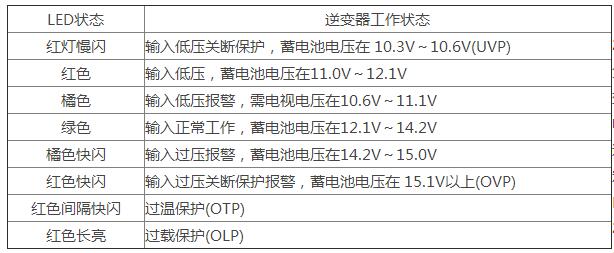
2-1. Check if your load is within the range of the voltage and current output from the inverter and the rated power of the inverter.
2-2. You must properly maintain and maintain your inverter power supply. Wipe the external dust and stain of the inverter power supply with a damp cloth, and at the same time tighten the screws of the DC input terminal; use a high-pressure air gun to clean the internal dust and foreign matter.
2-3. The inverter must be turned off for cleaning and maintenance.
In addition, in the maintenance of the inverter, it is best to do the following: First, we must regularly check the internal connection of the product is not solid, but also check the line part is not intact, if there is abnormal, it is necessary Timely replacement. Secondly, during the use of the inverter, if there is a problem, it is necessary to immediately stop the machine for inspection. After the problem is solved, it can be used again. Third, in the course of maintenance, unclear breakdowns should be recorded in advance, and the manufacturer should be asked to proceed. Fourth, when cleaning the inverter, use a soft cloth for scrubbing. Do not eat scrubbing tools with too much friction. Fifth, we must regularly check its cooling holes and seals are not blocked, if any, to remove dust in a timely manner.
3. Troubleshooting
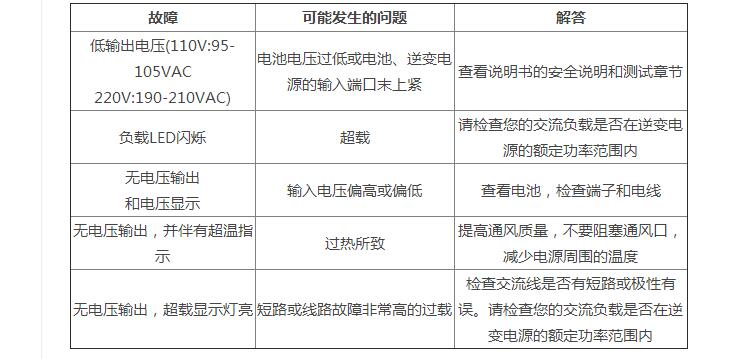
Electric Type Light Tower,Portable Mobile Light Tower,Industrial Mobile Lighting Tower,Industrial Portable Lighting Tower
Wuxi Doton Power , http://www.dotonpower.com